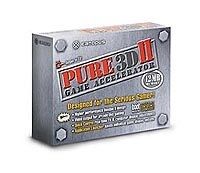
20 Years of Military Flight Simulations, 1980-2000
Part 2: The Growth Years: 1990-1996
A-10 Tank Killer
In 1989 President Ronald Reagan left the White House, and there was an explosion of new simulation titles.
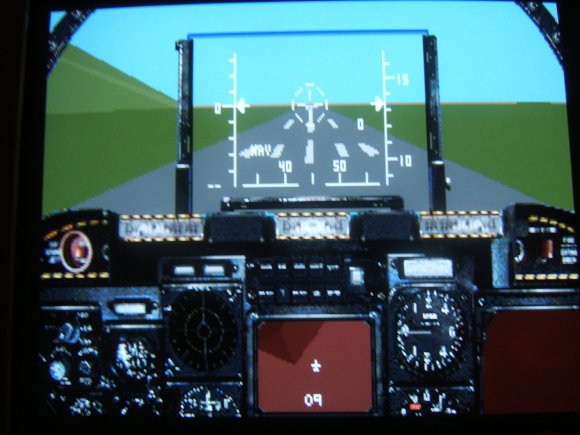
A-10 Tank Killer
Sierra released A10 Tank Killer, Blue Max ran in 256 colors (VGA), and Microprose released F-15 Strike Eagle II.
I don’t remember much about A10 Tank Killer, but I had seen the ads for F-15 Strike Eagle II and I ordered it via mail.
F-15 Strike Eagle II's environment was as interactive as that in Falcon AT.
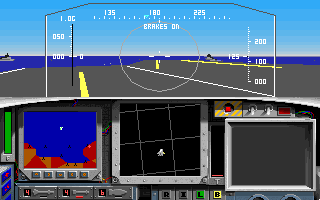
F-15 Strike Eagle II
SAM sites were a constant threat, and bandits would pick up the chase on your flight home. This kind of dynamic environment was a huge leap in technology. F-15 Strike Eagle II also offered an expanded view set. The player could look to the side or to the back and see the world outside, as well as parts of your cockpit. Suddenly the aircraft itself had internal dimensions.
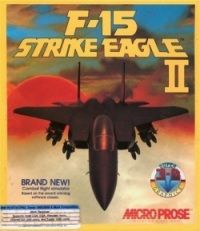
Furthermore, F-15 Strike Eagle II offered the first "Director Mode,& where you didn’t have to fly but could simply sit back and watch the action. This mode continued to evolve until DiD appeared with their excellent Smart View system in EF 2000 in 1994.
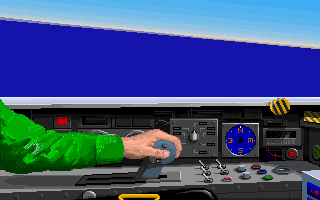
F-15 Strike Eagle II
With 256 colors, F-15 Strike Eagle II was glorious in its time. VGA graphics were still new to the scene, and a good VGA board like the Paradise one I ordered in 1988 set me back around $200 US.
Microsoft Flight Sim 4
In the same year Microsoft released Microsoft Flight Simulator 4. This was a true flight simulator, since it modeled the forces of flight as well as aircraft avionics. The game itself looked good at the time, and spawned many add-ons. Many flight sim fans got their start in the genre with Microsoft Flight Simulator 4.
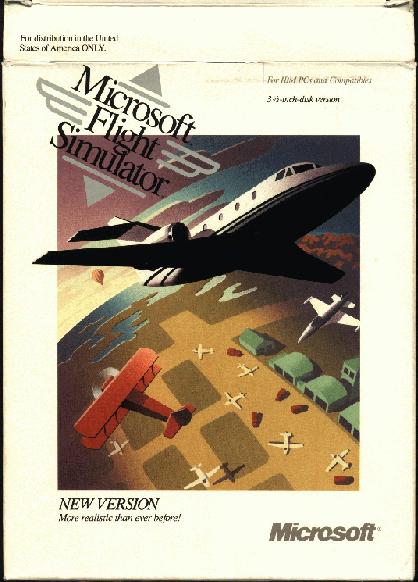
Microsoft Flight Sim 4
One area that still needed serious improvement was sound. Sound hardware was not keeping pace with the software, though I believe I had my first Sound Blaster around 1989. Up to this time there was no real standard, so compatibility was hit and miss. This as well as memory requirements and processor limitations meant that digitized sound had not yet appeared in flight sims. The engine sounds in the Cessna in Microsoft Flight Simulator were more like a buzz saw than an aircraft engine, and the rate changed while the tone varied little.
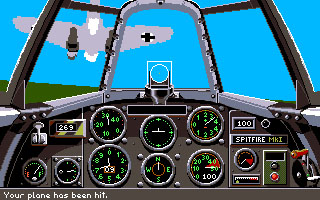
Their Finest Hour (Battle of Britain)
1989 also saw the release of a classic, LucasFilm Game’s Their Finest Hour (Battle of Britain). George Lucas was a WWII buff, and this interest inspired the famous Star Wars dogfight scenes. Incredibly, even this game still fit within the 640K limits imposed by DOS.
But Their Finest Hour (Battle of Britain)sported the first ever dynamic campaign system. Designed by Lawrence Holland and programmed by Holland and Lincroft, the game was years ahead of its time. Even the manual was unusual.. spiral bound, and with a great deal of historical detail included, with many quotations and pictures from WWII.
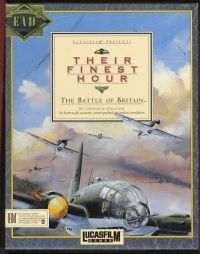
In August, 1990 the Gulf War erupted. John Major came to Downing Street in the same year, and military flight simulations exploded, with at least eleven PC titles. The classics included Chuck Yeager's Air Combat, Secret Weapons of the Luftwaffe, and Air Warrior .
Chuck Yeager's Air Combat
Chuck Yeager's Air Combat had one of the first "gun camera" features and pop-up windows that helped you keep track of the target. This feature would later be refined and show up again in USAF, US Navy Fighters, Advanced Tactical Fighters and World War 2 Fighters. Developed by Brent Iverson, the game loaded with an 8 bit voice sample from Chuck Yeager, "It’s a great day for flying!" This was Iverson and Electronic Art’s first entry in the combat flight simulation genre.
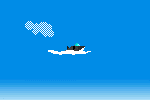
Chuck Yeager's Air Combat
Secret Weapons of the Luftwaffe was another 256 color game, and it allowed the player to fly seven different Luftwaffe aircraft, including three experimental jets like the Gotha 229 flying wing. Following on the heels of Their Finest Hour (Battle of Britain), this Lawrence Holland game used a refined dynamic campaign engine and included the same features as the earlier effort.
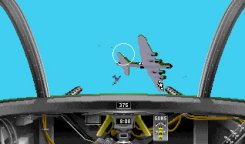
Secret Weapons of the Luftwaffe
The detail in Secret Weapons of the Luftwaffe, was amazing for its time. Tour of Duty mode allowed the player to select from three different careers: as a fighter pilot, a bomber pilot, or as bomber crew. The average tour was from 25 to 35 missions in length. Full records were kept of all flights, weapons could be selected and loaded, and the flight roster could be managed by the player.
Players could choose from the Flight School, Historical Missions, Custom Missions or the Tour of Duty mode. The fifth choice was the dynamic Campaign mode, which allowed the player to command various large-scale campaigns and even alter the outcome of history.
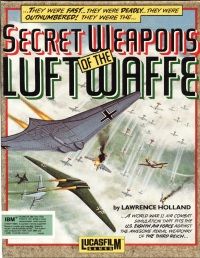
The campaign mode in SWOTL didn’t involve only flying, but also economic management. On the German side, in addition to directing fighter defense, the player controlled the production of war material, choosing what was produced at aircraft assembly plans, engine factories, oil refineries, and even research and development factories. These decisions affected later availability of aircraft and parts in the campaign.
On the US side, the main concern was to select strategic targets to cripple German production. The player created and selected flight groups and then planned the raid and then flew in it. Sounds a little like the later B-17 Flying Fortress: The Mighty Eighthdoesn’t it?
F-117A Stealth Fighter
1991 saw the release of another eleven titles for the PC. Birds of Prey EA included in flight refueling!
Microprose's F-117A Stealth Fighter included carrier launches and landings.
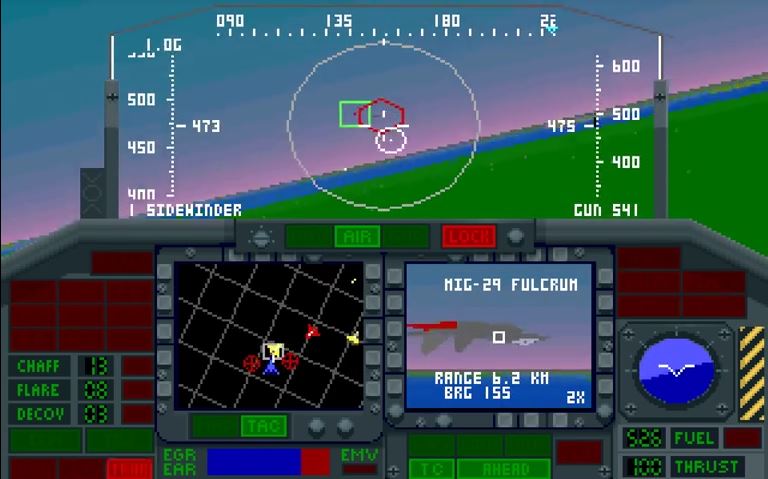
An atmospheric game, F-117A Stealth Fighter began to show some sophisticated avionics and weapon systems, and required some tactical thinking to survive.
Other titles in 1991 included Falcon 3.0, Gunship 2000, Jetfighter II, MiG-29M Super Fulcrum (1991) and Red Baron.
Of all the titles, Falcon 3.0heralded a new generation in simulation technology.
Falcon 3.0 had the first dynamic campaign system, involving the player in an ongoing battle in a persistent world, with the forward line shifting with the fortunes of war. Falcon 3.0 was probably the first simulation to have a padlock view, simulating the player turning his head to keep a fix on the bandit.
AI wingmen reached a new level of sophistication. They helped in combat, and even warned the player of threats. Damage models had begun to improve, and Falcon 3’s mission designer allowed the creation of complex combat scenarios
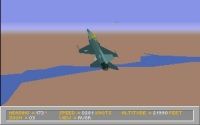
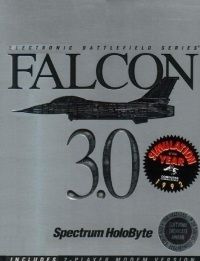
The inclusion of networking features gave birth to virtual squadrons and a true flight simulation community, even before the Internet. Falcon 3.0 also featured a working ACMI recorder, allowing the player to examine his maneuvers after the mission from a variety of perspectives. Finally, Falcon 3.offered a hi-fi flight model which could be activated on the top end hardware of the time, a 486/33 or higher.
ThrustMaster
Somewhere around this time ThrustMaster released their FCS and WCS HOTAS controllers. ThrustMaster was founded by Buzz Hoffmann, an ex-USAF fighter pilot around 1990 with the idea of creating high end controllers for the growing flight simulation industry.
Real pilots don’t have to worry about hitting keys when they are in combat. In fact, taking one’s eye off the enemy is a good way to get killed. Buzz knew from experience that good controllers could make a huge difference to immersion and success in the virtual combat pilot experience, and he set out to develop controllers that looked, felt, and worked like the real thing.
1992 saw nine new titles for the PC and a shift to prop combat. The five titles included Dynamix classic: Aces of the Pacific, MicroproseB17 Flying Fortress and Rowan’s Reach for the Skies, complete with gourad shading!
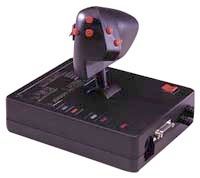
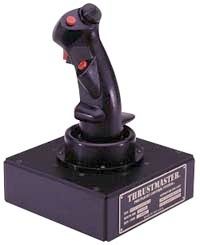
Damon Slye at Dynamix
Aces of the Pacific demonstrates the increasing production effort directed toward combat flight sims. Damon Slyeat Dynamix had a special interest in their flight sim products, beginning with the highly successful Red Baronin 1991.
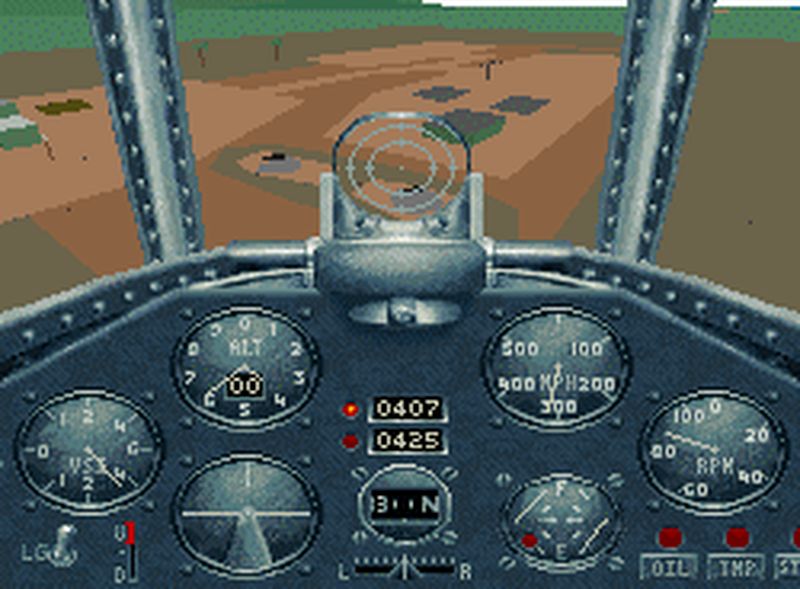
Aces of the Pacific included a beautiful spiral bound 240 page manual, including color plates of all the key aircraft in the conflict (25 of which are simulated). The game also featured a mission recorder, allowing the player to fly a mission and record it for later replay, even jumping back into the mission at any point.
As I examined the old Aces of the Pacificbox, I found two leaflets which preserve some of the magic of those years for Dynamix. The first promotes "The Sierra Network," with the new "interactive Dynamix simulator game RED BARON." TSN (The Sierra Network) is described as "the world’s first electronic entertainment community."
The second leaflet is actually a beautiful navy colored brochure with a "Great War Planes" logo on top. The brochure promotes the three Dynamix simulations available at that time: A10 Tank Killer, Red Baron and Aces of the Pacific. It is obvious that Dynamix intended to continue the series.
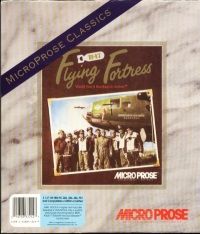
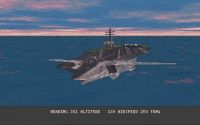
1992 also saw the release of Novalogic’s Comanche and Microprose F-15 Strike Eagle 3. Novalogic, a new arrival in the simulation field, used a new technology called Voxel Space to produce incredible low level detail for terrain, creating a tremendous sense of speed. Weaving in and out of canyons was sensational. Strike Eagle III allowed co-op multiplayer front seat, back seat gaming, and had excellent tutorials. Missions were diverse and challenging and avionics were detailed.
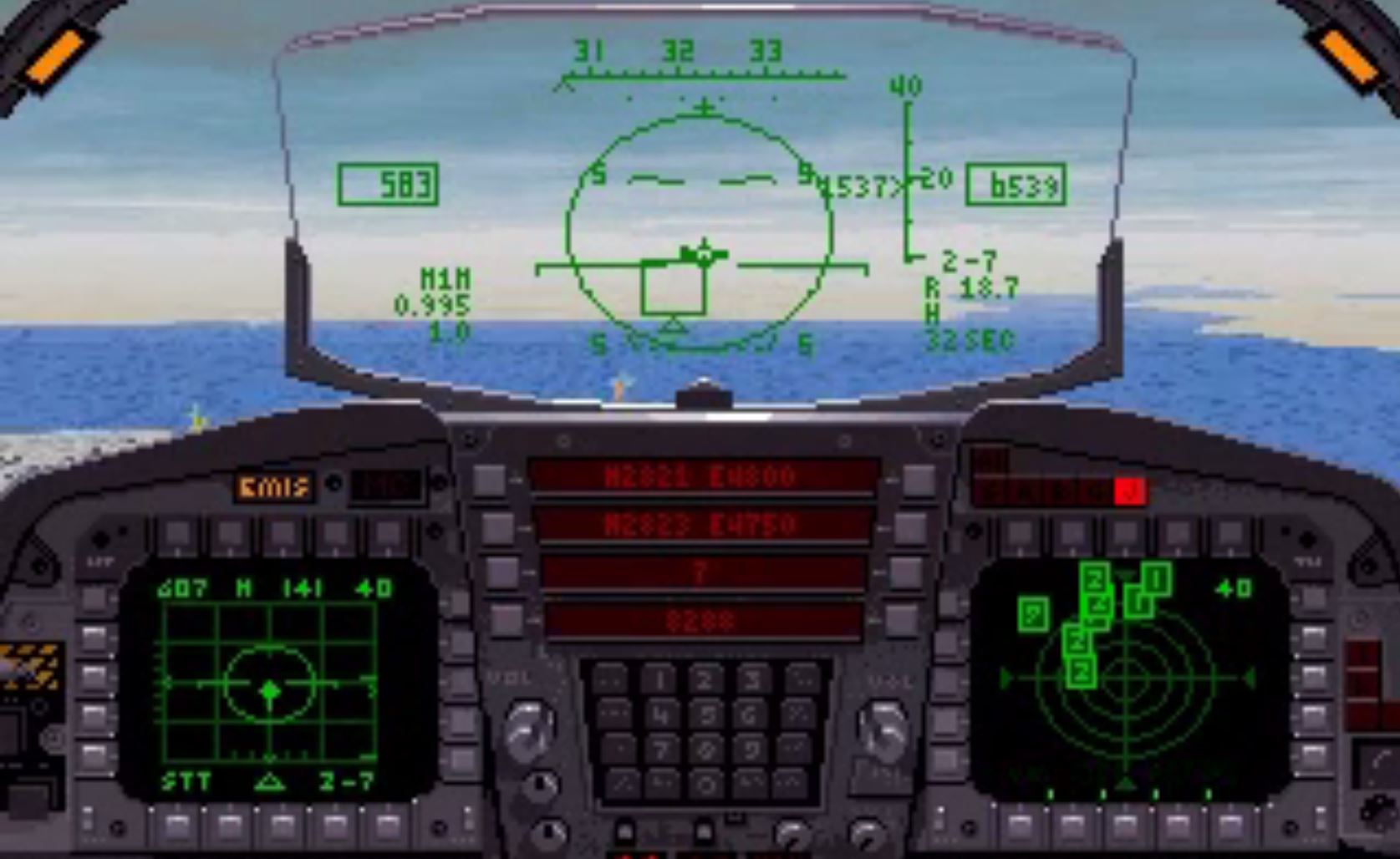
Microprose F-15 Strike Eagle 3
TFX required 4MB of memory to run!
In the same year Microprose released Fleet Defender, modeling both pilot and WSO positions in the F-14. This one was outstanding for carrier ops, with excellent voice interaction, good wingman control and incredible dawn and dusk lighting. Two manuals detailed weapon systems, tactics, and operation of the Tomcat.
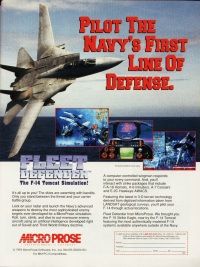
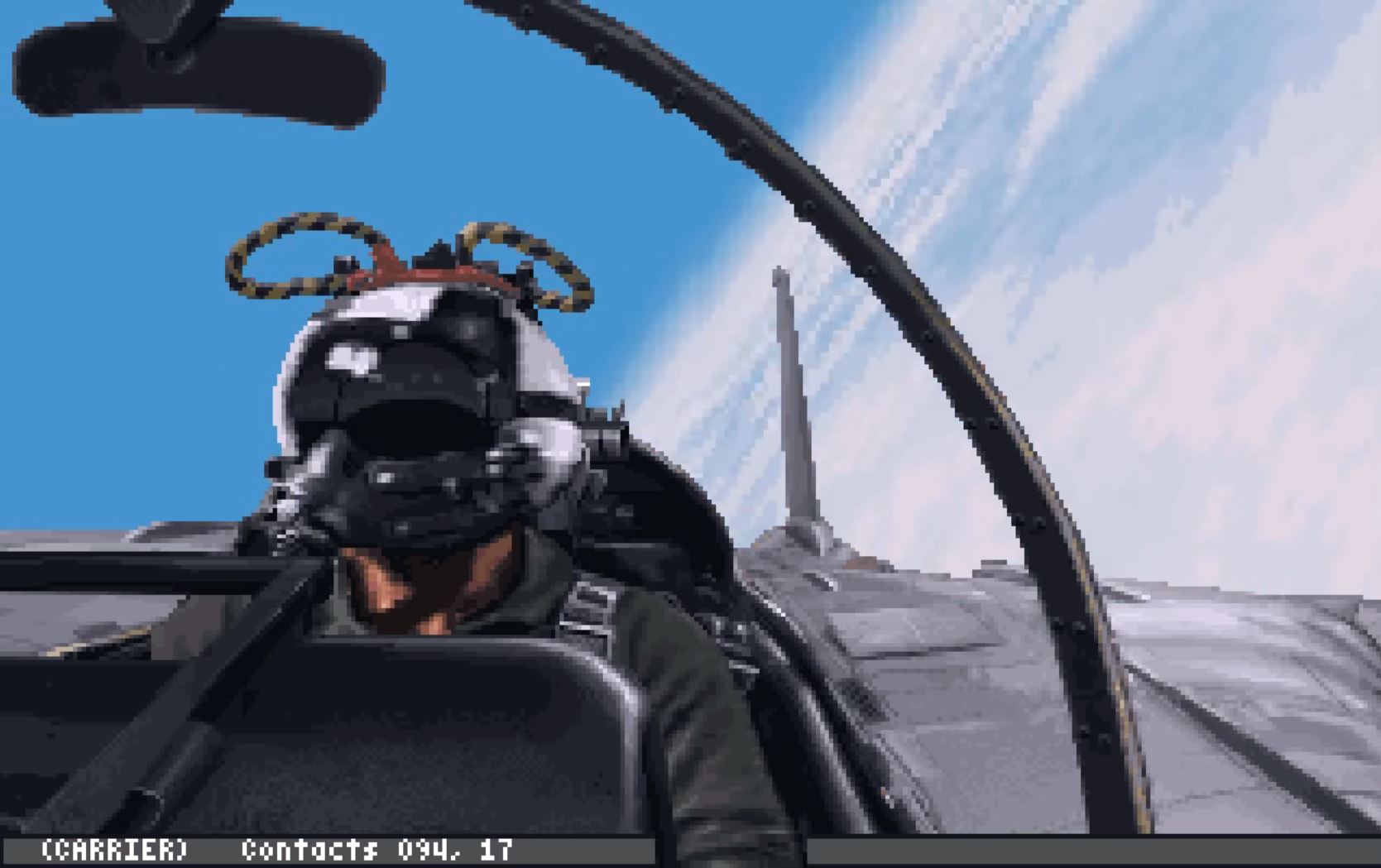
Fleet Defender
Bill Clinton became President in 1993, and ThrustMaster released their F-16 FLCS.
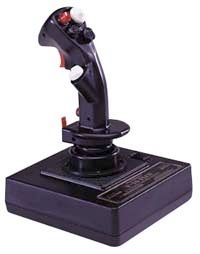
There were seven combat flight sim releases for the PC.
Dynamix released Aces Over Europe (1992), and Spectrum Holobyte released their Hornet add-on for Falcon 3.0. Origin released Strike Commander with high detail texture and a scrolling virtual cockpit.
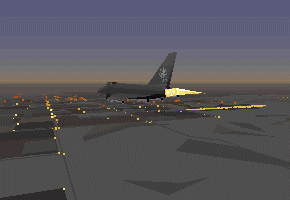
TFX
Digital Image Design made their first entry for the PC in 1993 with TFX. TFX required a 486 with 4MB of free memory. Textures were highly detailed and the game featured a UN Commander mode which allowed the player to plan the campaign missions and fly the EF2000, F22 or F117.
MiGMan: Digital Image Design released F-29 Retaliator in 1989. See Digital Image Design for more details.
Tornado
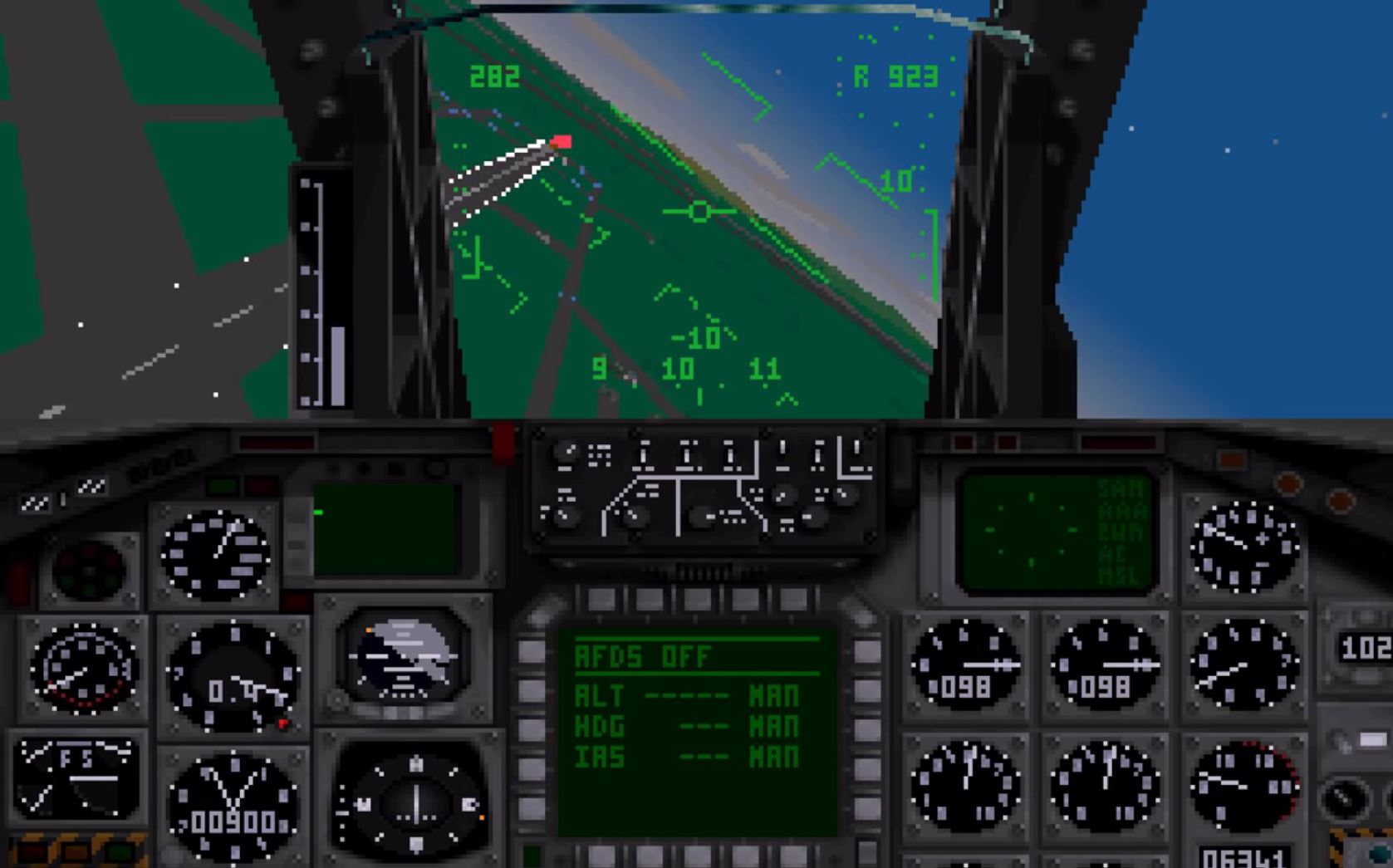
1993 also brought Tornado (1993), the classic from Digital Integration. With a 330 page manual, the game allowed detailed mission planning and sported a dynamic campaign system. It quickly became a huge success as virtual squadrons formed to plan tactics and fly together via modem or LAN.
1994 roared into life with Microprose's 1942 The Pacific Air War, the best WWII simulation at the time. Flight models and the AI held great challenge; almost too much since the AI pilots pulled superhuman maneuvers. Graphics were limited to 320x200 but looked good.
I spent many hours in 1942 The Pacific Air War, and it was an atmospheric game. The manual was a spiral bound collection of history and anecdotes, including color plates for each of the key aircraft in the conflict.
In the same year Domark released Flying Nightmares, an AV8B Harrier simulation. Origin released Pacific Strike in 1994, and EA released US Navy Fighters. Meanwhile, Empire released Rowan’s Dawn Patrol.
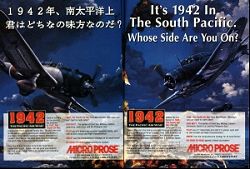
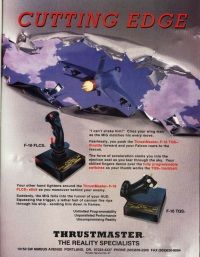
These last two titles both pushed the envelope for raw beauty, with US Navy Fighters allowing up to 1024x768 resolution. US Navy Fighterswas great fun and combat action was intense, with powerful wingman control and good voice interaction.
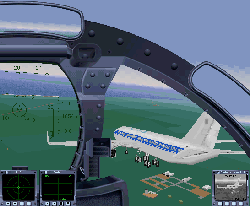
USNF
Meanwhile, Dawn Patrol set a new standard for flight modeling. Sometimes challenging to configure, it came to life on the new Pentium 90 systems introduced in the latter part of the year and modeled a large variety of WWI aeroplanes.
ThrustMaster’s F-16 Throttle Quadrant System
ThrustMaster’s F16 TQS appeared early in 1994, the first separate throttle controller that accurately represented the throttle in the F16. With the combination of the F-16 FLCS and TQS, TM took the lead with the most flexible, most programmable, and heaviest flight combat hardware ever seen by gamers. Some uses claimed they could make these controllers sing and dance, and the likes of Bill "Cowboy" Wilson did just that.
On the downside, using the DOS utility to access the logical programming features to achieve the results desired could be a challenge. Calana software addressed that need with their CS Commander software in 1994.
16 bit sound cards were also making their debut in 1994, with companies like Creative Labs and Media Vision pushing the hardware boundaries.
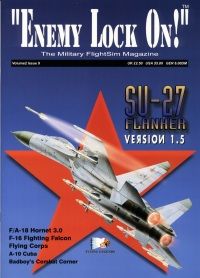
In January, 1995, the first issue of Enemy Lock On was printed, a British magazine dedicated to military flight simulations. ELO sold by subscription only, and when it finally ended publication around 1998 the subscriber base exceeded 15,000.
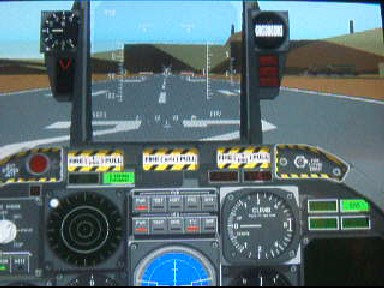
1995 saw the release of Activision’s A-10 Cuba, Eric "Hellcats" Parker’s excellent production. A10 employed dated 256 color graphics but had excellent flight, damage and physics modeling. The cockpit was the most detailed yet seen, with working instruments and mouse-able controls. This was probably the first mouse-able cockpit to appear on the PC.
A-10 set the standard for physics for the next few years, and I still remember the first time I landed an ailing Warthog on a single engine and single gear strut and pirouetted down the landing strip.
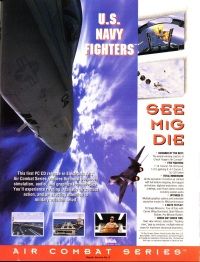
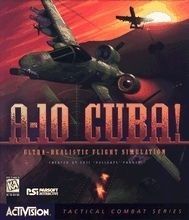
EA released Marine Fighters>, based on the US Navy Fightersengine. Origin jumped back in with a WWI title, Wings of Glory. The show was stolen, however, by DiD’s EF 2000 and SSI’s Su-27 Flanker, the first native WIN95 sim.
The cult of Su-27 Flanker
Su-27 Flanker was designed by a Russian team, and modeled systems and aerodynamics in great detail. 256 color graphics were becoming dated, but no one seemed to care!
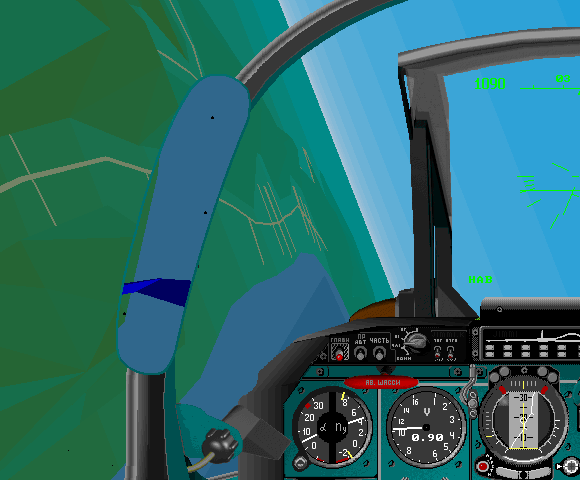
Su-27 Flanker developed something approaching a cult following, and its multiplayer LAN features made it a popular simulation with online pilots. Virtual squadrons quickly formed around Su-27 Flanker.
Sometime in the summer Braveheart was released, a role that would vault Mel Gibson to legendary status. This story of leadership and courage in the face of oppression, told with bold strokes and in exquisite detail, dominated the movie scene in 1996.
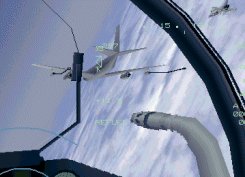
EF 2000is the best all-around modern military jet sim ever, and will probably age very well. Sure, Su-27 Flanker has a fabulous flight model and Back to Baghdad has some awesome avionics, but who else puts it together with a dynamic campaign, a decent wingman command structure for good tactical play, and incredible graphics? And the avionics in EF 2000can stand on their own, requiring dedication to learning the systems.
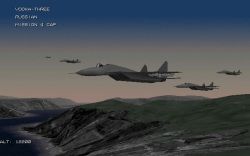
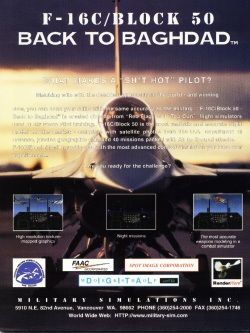
The campaign mode was incredible, and multiplayer coop single missions were supported. EF2000 defined 'immersion' and the 'willing suspension of disbelief.' It was the first simulation with a fully believable environment, and won great critical acclaim. EF2000 cheated somewhat on campaign dynamics, but it was atmospheric and challenging.
Like Su27, it sported great LAN code and became an online favorite, causing some to remove the aging Falcon 3.0 from their hard drives. Virtual squadrons sprang up world-wide devoted to multiplayer gaming with EF2000.
Electronic Arts and Janes Combat Simulations
The minimum system requirements as specified on the original EF 2000box call for a 486 DX2/66 with 8 MB of system memory. In order to run with all graphics options at high resolution (640x480) and a good frame rate a Pentium 90 with 32MB was more like it.
Sometime around 1995 Electronic Arts struck a deal with Janes, of civil intelligence fame, to use their name on a new line of serious military simulations. Jane’s Combat Simulations was born, with Paul Grace and Andy Hollis (who produced Strike Eagle II and III) the primary personalities involved.
In January, 1996 the first issue of PC ACE appeared on news stands and ThrustMaster released the F22 Pro.
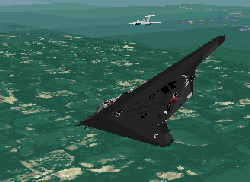
Jane’s/EA released Advanced Tactical Fighters, built on the US Navy Fightersengine but proving more popular than US Navy Fighters.
MSI released Back to Baghdad, an F16 simulation based on Desert Storm. Novalogic’s F22 Lightning II hit the tarmac, and Philips Media released Fighter Duel. This prop simulation was specifically designed for multiplayer mayhem, was a landmark work graphically and the first to work online.
1996 saw the release of Andy Hollis’ first Janes title, Longbow.
Dynamix released A-10 Tank Killer 2: Silent Thunder and Graphic Simulations released Hornet 3.0. Of these, the classic titles were Longbow and Hornet 3.0.
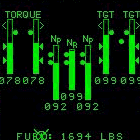
Longbow should fairly be identified as the first of the modern systems simulations. It was accompanied by a thick manual on using the various radar modes and weapon systems of the AH-64D. It required dedication to learning the systems, particularly when the battle got hot, not to mention making best use of your wingman for joint tactics.
The steep learning curve was made easier by the first ever virtual instructor. A voice narration led the player step by step through the systems in a series of training missions. The instruction required a response from the player, so it was only possible to move through the missions by actually responding to the instructor. Longbow featured a semi-dynamic campaign system that was involving and convincing.
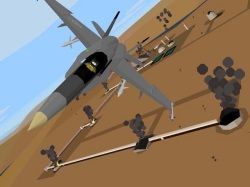
Hornet 3.0 was almost as challenging, but using only 256 colors, didn’t look as good. Nevertheless, Hornet was a realistic simulation of the weapons and targeting systems of the F-18 Hornet. The manual was written by an ex-naval aviator, and the set of training missions were extremely well done. Unfortunately, the campaign was a series of individual missions and was not very immersive. Hornet 3.0 was released for both the Mac and the PC.
3DFX
In 1996 3dfx released a dedicated 3d accelerator, and suddenly the graphical complexity of games leapt forward a generation. Up to this time memory on video boards was strictly framebuffer memory, with VGA boards sporting 512K of memory. There was no acceleration of texture rendering in 3d games, with the host processor doing all the work.
3DFX released their first "Voodoo" board with 2 MB of framebuffer memory, and 2 MB of texture memory. The additional framebuffer memory paved the way for higher color depths at higher resolutions, and the texture memory stored the surface images that are applied to the polygons that make up objects in games.
16 bit color and 3d acceleration had arrived for the PC. Not long afterward, EF 2000v.2 was released with 3dfx support. The difference was stunning, and there was no going back.
